• Dahabiya Nile Sailing •
Short Description:
This tour not only covers the highlights of Egypt, but also covers many off the beaten track hardly visited by tourists. The highlight of this tour is sailing the Nile in comfort on board a traditional sailing boat called Dahabiya, as the Ancient Egyptians did thousands of years ago. In this tour, you also have the chance to explore parts of the untouched Egyptian desert and enjoy the peace and simplicity of Desert Oasis.
Day 1
Visit Saqqara. Include the Step pyramid, Titi pyramid, the Nobles tombs.Visit Dahshur. Include the Bent pyramid and the Red pyramid.Lunch at Saqqara, a good place to try Egyptian food. Normally they serve a mix of grilled, kofta, and lots of small dishes filled with appetizers.Visit Memphis. Including the Colossi of Ramses, the open air museum and other archeological sites recently open to the public.Tour duration 7 – 8 hours.Night stay in Cairo.
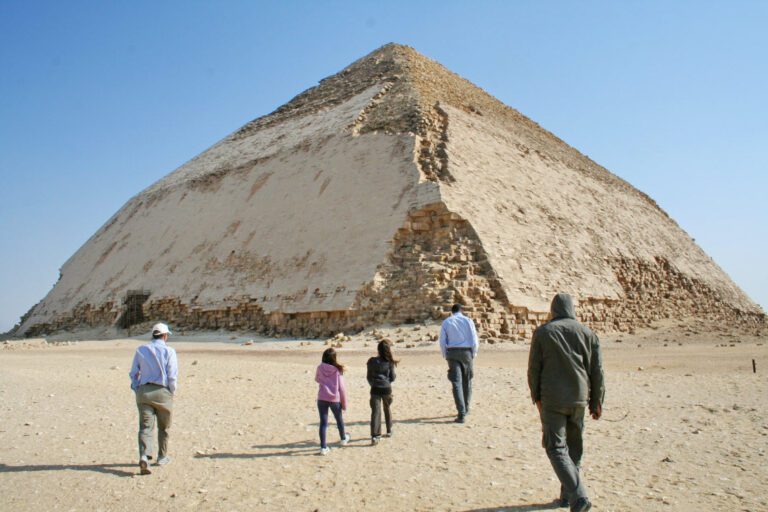
30 km (19 miles) from Cairo, Saqqara is an archaeological site which continues to reveal its treasures through new discoveries. The site covers 7km (4.4 miles) on the West bank of the Nile. Best known for its step pyramids, Saqqara was the necropolis of the capital, Memphis. Buried here were people and also many sacred animals. Construction here continued from 3,050 BC with 1st Dynasty funerary structures to 6th century AD Coptic monasteries. The highlights of the site are the step pyramid (pyramid of Djoser), pyramid of Unas, and the Nobles tombs. Other sites may be visited depending on time and availability, such as the Serapeum and Imhotep Museum.
10 km (6 miles) south of Saqqara we visit Dahshur, which shows the change from the step pyramid method of construction to the true pyramid shape. Two of the pyramids here are among the oldest, largest and best preserved in Egypt. These were commissioned by 4th Dynasty king Snefru (2649-2609 BC). Highlights of the site include the Bent pyramid, Red pyramid which is second in size only to the great Giza Pyramid, and other pyramids.
Lunch at Saqqara, a good place to try Egyptian food.
Established by King Menes or Narmer (3050-2850 BC) who united Upper and Lower Egypt, Memphis was the capital city of ancient Egypt for more than 1,000 years. Although little remains of the city, at its peak it had many temples, palaces and gardens. We see the Colossus of Ramesses II, carved from limestone and about 12.8 metres. (42 feet) high. The remains of the Temple of the God Ptah are still visible, other remains and artefacts include a large alabaster sphinx.
Day 2
Visit Giza. Including the Great pyramid, The Sphinx, The Valley Temple, Khafra pyramid, Menkawra pyramid, and the nobles’ tombs.Lunch at Abo Tarek, famous for Koshri as the most common fast food in Egypt, is a mix of rice, pasta, lentils , chickpeas, fried onion, and tomato sauce.Visit the Egyptian museum. Including King Tut Ankh Amon collection and The Animals Mummies room. Or visit the Grand Egyptian Museum when opens. Walking tour in Downtown Cairo. The most famous among the area was during Egypt Revolution.The tour duration 8-9 hours. Tahrir Square, the birthplace of Egypt’s great revolution and visit the places where important events happened.Night stay in Cairo.
Optional tours and activities
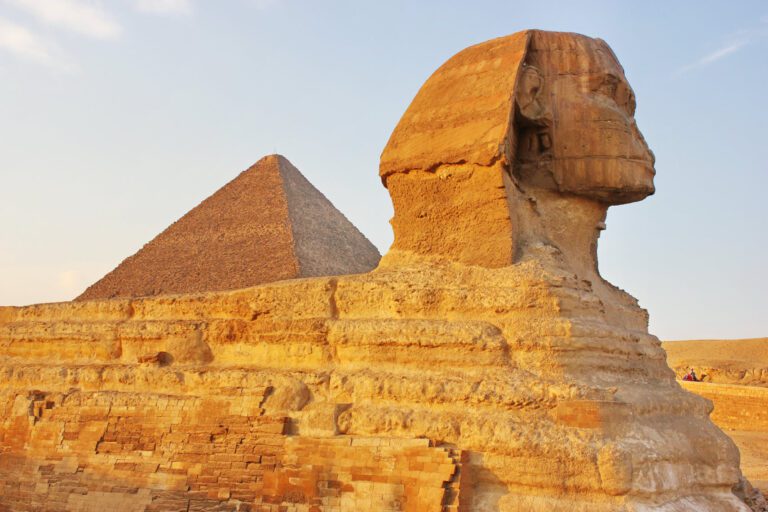
The Giza pyramids are the only survivor of the Seven Wonders of the Ancient world, more than 4,000 years after their construction they still leave visitors in fascinated awe. The Great pyramid of Khufu (2609-2584 BC) is the largest pyramid in Egypt and the world and the
oldest of the Giza pyramids, 138 metres (453 feet) high. We also see the pyramids of Khafre, Menkaure, and pyramids of the Queens. Entering the Great pyramid is an option and a memorable experience, however this is not recommended if you experience claustrophobia
or are not in good health. The interiors of the pyramids are not decorated but are noteworthy for the advanced engineering involved in their construction. Other attractions include the Sphinx and its Temple. The Sphinx was carved from one piece of limestone and is 60 meters (197 feet) long and 20 meters (66 feet) wide.
Lunch at Abo Tarek restaurant which is famous for koshari, the most common fast food in Egypt, a mix of rice, pasta, lentils , chickpeas, fried onion, and tomato sauce.
Visit the Egyptian museum, including the King Tutankhamun collection and the Animals Mummies room. OR visit the Grand Egyptian Museum, when it opens. The museum
contains a vast collection of artefacts and gives you an understanding of the richness of the
art and culture once situated at many of the sites you will visit elsewhere in Egypt.
Overnight stay in Cairo.
Day 3
Transfer to Cairo airport and fly to Luxor. 1 hour flight. Visit The Valley of the Kings, The Colossus of Memnon and Hatshepsut temple. The tour duration 5-6 hours. Lunch.
Check in the hotel.
Afternoon: Visit the Ancient workmen village of Dier Elmadina, and Habu temple. Visit a local farmer family in Luxor and have dinner in their house.
Night stay in Luxor.
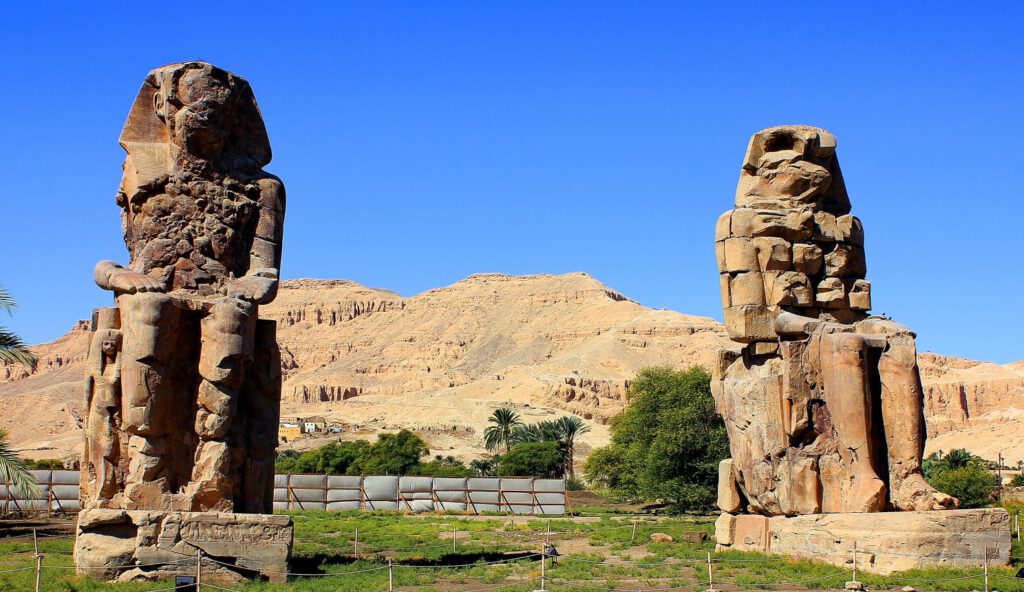
On the West bank our first stop is to see the Colossi of Memnon. These two imposing sandstone statues indicate the site of the mortuary temple of 18th dynasty pharaoh Amenhotep III (1386 – 1353 BC). 18 meters (59 feet) high and each is estimated to weigh 653 tonnes (720 tons). Visit the Valley of the Kings where your tour guide will lead you to the most important tombs among the currently open tombs in the valley. You visit 3 tombs of the more than 10 tombs that are currently open. Visit Hatshepsut temple. Lunch.
Deir el–Medina is the Arabic name for the village where the craftsmen and artisans who worked on the tombs and other monuments of the West bank lived, including those in the Valley of the Kings and Valley of the Queens. It is an important site due to the abundant information it has given about the daily life of those who lived here. at Deir el Medina the lives of the workers responsible for the magnificent tombs were coming to light.
Medinat Habu (Habu temple) features the impressive mortuary temple of Ramses III and also encloses a well preserved pharaonic palace. The site is unique because it is one of the few where you can find the resting house of a king, giving insights to their daily life. The site was a complex of temples dating from the beginning of the New Kingdom (1569 BC). A temple to Amun was built here by Hatshepsut and Thutmose III. Ramesses III also chose this site as the location of his mortuary temple and commissioned a massive mud-brick enclosure around the entire site; within this were included storehouses, workshops, administrative offices, and residences of priests and officials. The walls sheltered the entire population of Thebes during the Libyan invasions of the 21st Dynasty (1081-711 BC), and for three centuries afterwards it protected the Coptic population. The temple precinct is about 214 meters (700 feet) by 305 meters (1,000 feet). The reliefs at the front of the temple depict Ramses III as victor in several wars. Attached to the temple is one
of the few king’s houses remaining, the throne room and other spaces are well preserved.
You will also see remains of an early Christian basilica, and a small sacred lake.
Overnight stay in Luxor.
Day 4
Visit Karnak and Luxor temples. The tour duration 3-4 hours.To join the dahabiya, which is part of the Luxor governorate, we drive about an hour from Luxor to Esna. We visit the Temple of Esna and restored caravanserai and market, then check in to the dahabiya and sail to El Hegz Village for a unique cultural experience. Lunch and dinner are on board the dahabiya.
Optional Tours :-
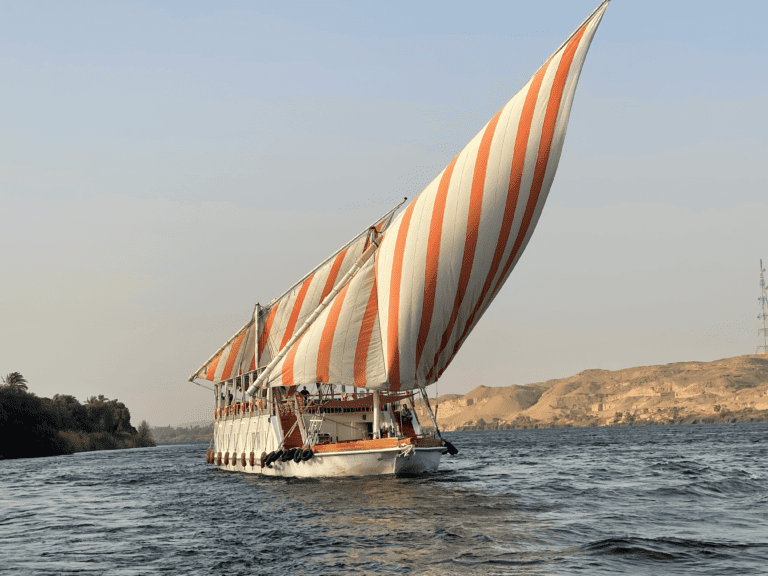
On the East bank of Luxor, bookending the modern city, are the ancient Theban temples of Karnak and Luxor, with the Avenue of Sphinxes and Luxor Museum between them.
Luxor Temple is located approximately three kilometres (1.86 miles) south of Karnak Temple. These temples were linked with a processional way bordered with sphinxes, now known as Avenue of the Sphinxes. It is the only temple in the world where ancient Egyptian religions, Greek and Roman cults, Christianity and Islam have been practiced. The temple was substantially built by Amenhotep III (c.1390–1352 BC) and Ramesses II (1279–1213 BC).
Karnak Temple is huge, the site covers more than 100 hectares (247 acres). Construction at Karnak began during the reign of Senusret I in the Middle Kingdom (2000 – 1700 BC) and continued into the Ptolemaic era (305–30 BC). Most of the remaining structures are from the New Kingdom, and these include remnants of temples, chapels, pylons and other structures. Most other temples in Egypt were not constructed and used over such a long time and with many rulers involved in construction here. Although it does not have many unique features, it is its size and variety within the site that make it extraordinary.
From Luxor we drive for about one hour to Esna. We explore Esna Temple which is dedicated to the ram headed god Khnum. The temple sits below street level within the town, as it was excavated from layers of earth. Enjoy discovering heritage craft traditions including beautiful textiles as we visit the restored Wekalet Al-Geddawi, a caravanserai, and the Ottoman era market of Al-Qissariya.
We return to the Dahabiya and enjoy lunch on board. We cross the lock and sail for about 4-5 hours to El Hegz Village. This is an opportunity for true cross cultural exchange as we visit a local family who are excited to have visitors from the wider world. Your guide will translate so you can ask them questions and enhance your understanding of village culture. Dinner and your first night on the Nile, enjoying the comforts of the dahabiya.
Day 5
Breakfast on board, sailing to El Kab. Transfer to see the massive walls of the ancient town of Nekheb and explore the New Kingdom tombs. Sail to Edfu, Ride to visit the Temple of Horus. Sailing with dinner and free time as you overnight on the dahabiya.
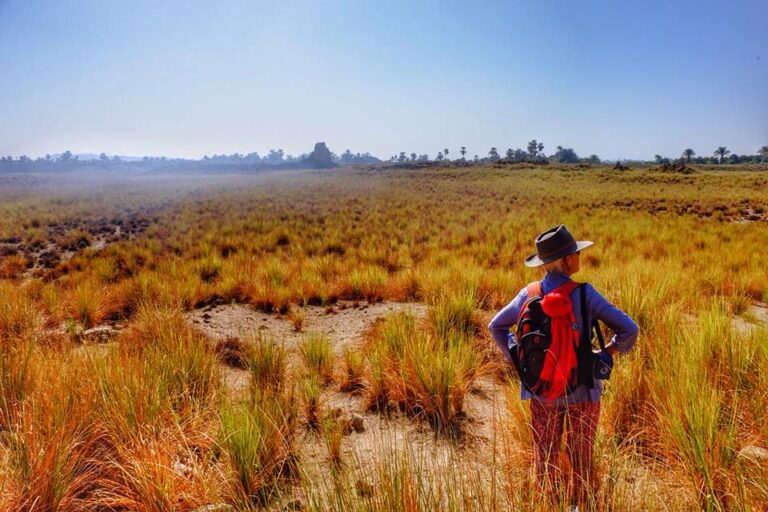
We disembark at El Kab where remains of ancient settlements date from about 3,000 BC (possibly centuries earlier) to Roman rule. The site is one of the most unique in Egypt because ancient villages and cities are rarely found. As we move inland you will see remains of the impressive mud brick walls and the long valley lined with tombs and shrines, including temples dedicated to Nekhbet and Thoth. We enter the decorated tombs of New Kingdom officials from the area.
We board the dahabiya for lunch and sail towards Edfu. Horse drawn carriages take us to the imposing Temple with its grand spaces and many hieroglyphic inscriptions. View Tell Edfu to the West of the temple, which includes houses dating from the Old to New Kingdom. If time allows we also stroll through the local market.
We sail again. From the boat view a Roman fort. Time to relax with dinner, and drift into dreams as you are now becoming part of the rhythms of the Nile. Overnight stay onboard at the island of El Fawza, which is a farming area.
Day 6
Breakfast on board. Visit Bisaw Island and village, join the men in their boats to share the experience of Nile fishing, walk through farms and meet the villagers. Sailing to El Selsela ancient sandstone quarry and shrines. Special barbeque dinner by moonlight.

Breakfast in a local home in Bisaw village, where we take a leisurely walk through a farm, meet some of the women and children and learn how the unique sun bread is baked in homes here. We are welcomed by the local fishermen to their boats, learning of the skills of these men who live in harmony with the Nile. Fish caught can be enjoyed as part of dinner that evening.
Lunch onboard and continue sailing to El Selsela where we take a short walk parallel to the Nile to visit shrines and a massive quarry. Large amounts of sandstone was quarried here for temple building in Thebes (Luxor). Cut into the rock are the speos (chapel) of Horemheb with its sanctuary containing rock shrines and various stelae and inscriptions. The huge quarry gives context to how much building material was sourced from this area. There is also an area of sand here where children (and children at heart) can slide and play.
Resume sailing until we reach a place for a special barbeque dinner by moonlight. Overnight stay on board.
Day 7
Breakfast on board. Visit Kom Ombo temple and the Crocodile Museum. In the nearby town of Daraw you learn how to shop like a local at the market, visit a barn to meet camels and learn about the camel trade, and visit a Nubian Town. As we sail closer to Aswan if you wish there is an opportunity to swim or kayak. Farewell dinner and sail to our final destination Aswan.
Optional Tours:-
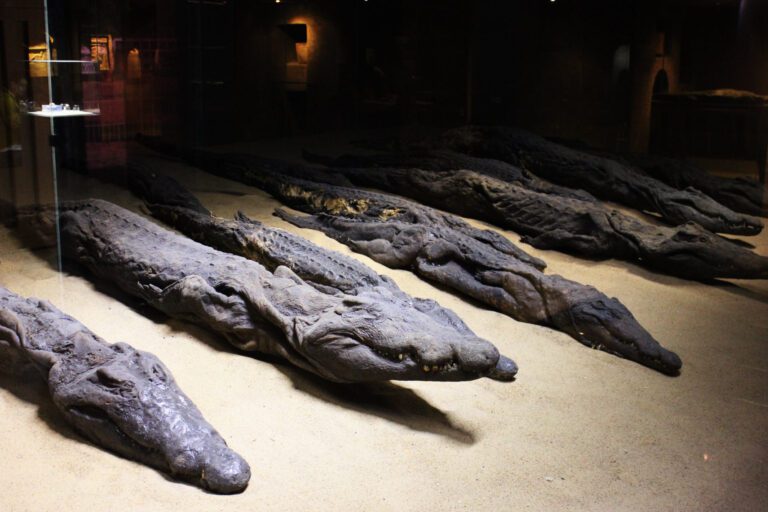
A short walk from the dahabiya dock, the Temple of Kom Ombo is dedicated to the crocodile-featured god Sobek and the god Horus. The connection to the power of the Nile is unmistakable as you look towards the temple. We also visit the Crocodile Museum which includes some impressive mummified crocodiles.
In nearby Daraw explore a town that will give you a different sense of Egyptian life than what you see in the big cities. Daraw includes several Nubian communities. We will stop at a cafe to try a local drink such as halfabar. We can plan our dinner for that night and learn how to shop, including a few words of Arabic, then try your new skills in the market shopping for ingredients for dinner. This is a fun opportunity to interact with the market traders. Ask your guide about shopping for other items too, including Arabic words and prices. You will visit a barn for an introduction to camels, giving you some interaction with camels and to learn about these fascinating animals and about the camel trade. Note: if your tour visits Daraw on Saturday or Sunday we visit the camel market instead of the camel barn. On Tuesdays we can visit a livestock market.
As we near Aswan you have the opportunity to swim or kayak. If you wish to kayak please advise us two days before the dahabiya tour begins so we can be sure to have kayaks available.
Sailing, lunch, dinner and overnight stay on board near Aswan.
Day 8
Breakfast on board and check out of the Dahabiya.Visit the Nubian Island of Elephantine , the archeological site, the Nuibian village and Animalia house museum and check in the hotel. Afternoon: Boat ride through the Nile 1st Cataracts and view the following: The Nobles tombs – Agha Khan Mausoleum – the Plantation Island and the Old Cataract hotel – see exotic plants and birds such as Black Ibes, Gray Heron and KingFisher. Lunch. Stop at the sand dunes in the west bank and hike the dunes for a great view overlooking the Nile River and the Desert during the sunset. The tour duration is 4 – 5 hours. Transfer to Philae temple and attend the sound and light show in the evening. If not available, will be replaced with a visit during the day. The tour duration is about 2 hours, including a 1 hour show. Dinner and night stay in Aswan.
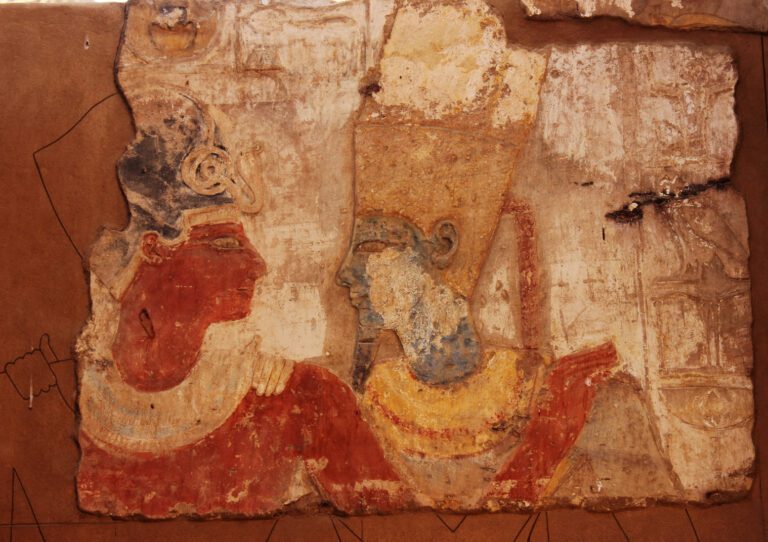
Check out from the Dahabiya and check in at the hotel.
Visit Elephantine Island archeological site. This is one of the most unique sites in upper Egypt because here you can see across 4,000 years of Egypt’s history, from 3,000 BC until late Medieval times (12th to 14th centuries). We visit a Nubian village and Animalia House Museum which is an excellent place to learn about Nubian culture and the changes that came about with the building of the High Dam. Lunch in a local home.
Afternoon: Boat ride through the Nile 1st Cataract, viewing: the Nobles tombs, Agha Khan mausoleum, Plantation Island and the Old Cataract hotel, see indigenous plants and birds such as black ibis, grey heron and kingfisher. Stop at the sand dunes on the West bank and hike the dunes for a great view overlooking the Nile River and the desert during the sunset.
In the evening take a boat to Philae temple and attend the sound and light show. If not available, this will be replaced with a visit during the day. During the 1960s the monuments on this island were relocated from the original Philae island nearby so they would not be flooded because of the construction of the Aswan High Dam. Philae includes many structures, mostly dating to the Ptolemaic era (332–30 BC), most prominent of these is a temple dedicated to Isis, begun by Ptolemy II Philadelphus.
Dinner and overnight stay in Aswan.
Day 9
Check out from the hotel in the morning. Travel to Abu Simbel in the morning. (3-4 hours’ drive along the desert)Visit the 2 temples of Abu SimbelDrive back to Aswan.
Note: Aswan – Abu Simbel – Round trip flights are available occasionally.
The tour duration is 8-9 hours.Lunch.Transfer to the Aswan airport and fly to Cairo. Transfer from Cairo airport to the hotel. Night stay in Cairo.

Check out about 5AM from the hotel. Travel to Abu Simbel by road and visit the temples.
280 km (174 miles) south of Aswan and close to the border of Egypt and Sudan is the town of Abu Simbel. We travel here to visit two massive rock-cut temples, the colossal statues on their facades are among the best known images of ancient Egypt.
In 1968 the temples were moved from their original location to avoid them being submerged due to construction of the Aswan High Dam. They were moved 64 meters (210 feet) above and 180 meters (590.5 feet) West of their original site. Both temples were commissioned by Ramesses II. The second temple is dedicated to the goddess Hathor and Queen Nefertari, wife of Ramesses II. Abu Simbel was admitted as a UNESCO World Heritage Site in 1979.
Drive back to Aswan. Visit the High Dam and enjoy views of the Old Aswan Dam and the Nubian Lake (Lake Nasser). Seeing the High Dam and lake adds to your understanding of how the changing flow of the Nile has influenced Egyptian history. The dam was built to control the flooding of the Nile, increase water storage for irrigation, and generate hydroelectricity. It was a controversial plan because the dam would flood the lands of the Nubian people and cover remains of previous societies including several important ancient Egyptian temples. However, the large area flooded caused the relocation of more than 100,000 people. Many archaeological sites were submerged.
Lunch. Transfer to the Aswan airport and fly to Cairo. Transfer from Cairo airport to the hotel, overnight stay in Cairo.
Day 10
Drive to Alexandria. About 3 hours’ drive each way. Visit the Roman theatre. Visit Alexandria’s new library and its archeological museum.Lunch.Check in the hotel. The tour duration is 3-4 hours.
Afternoon: Walking tour in the old market area and dinner. Night stay in Alexandria.

Drive to Alexandria, a city with many exceptional historic sites, a cosmopolitan culture, and Mediterranean Sea views. Alexander the Great founded the city in 332 BC. It became
renowned as a port and for its library and over subsequent centuries people from many countries settled here. It is Egypt’s second largest city, after Cairo. Spread along more than
30 km (19 miles) of coastline, Alexandria is especially popular in Summer with Egyptians travelling here and further along the North Coast to enjoy beautiful beaches. Highlights include the Roman theatre, the new library Bibliotheca Alexandrina and its archeological museum.
Lunch, we recommend a seafood restaurant as seafood is an important part of Alexandrian cuisine. In the afternoon, a walking tour of the Old Market area. Its many streets include hundreds of small shops and it gives you an insight into daily life in the city.
Overnight stay in Alexandria.
Day 11
Drive to the old town of Rosetta (Rasheed). Visit its museum and attractions. Walking tour in the old market. Lunch. Visit QaitBay Fort and the meeting point between the Nile and the Mediterranean Sea. Boat trip to Abu Mandour shrine. Drive back to Alexandria. Night stay in Alexandria. The tour duration is 5-6 hours.
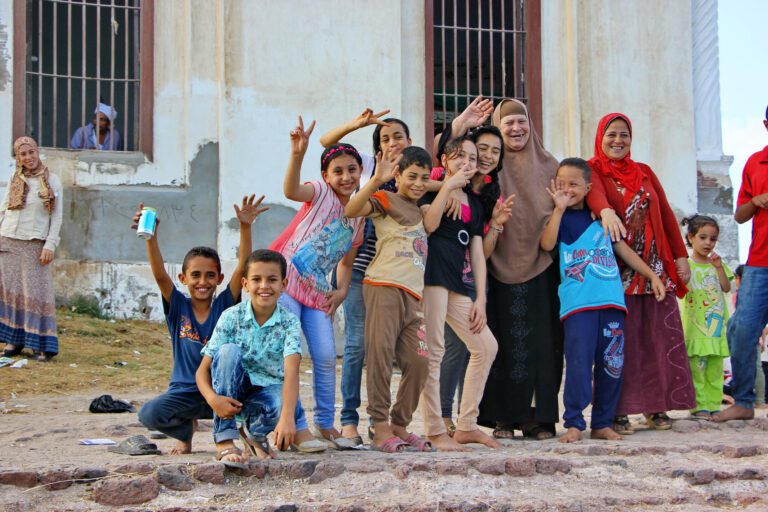
Drive to the old town of Rosetta (Rasheed). Rosetta, referred to in Egypt as Rasheed, is famous for the discovery of the Rosetta stone which made deciphering hieroglyphics possible. Due to the strategic position of Rosetta where the Nile meets Mediterranean Sea, it became an important trade centre throughout Medieval and modern history. Many mosques, caravanserai and houses are witness to the prosperity of the Medieval city. It is a tranquil place with extensive gardens, orchards and date palm plantations. Highlights include Rosetta National museum, QaitBay Fort, old houses and mills, Abu Mandour shrine. Drive back to Alexandria. Overnight stay in Alexandria.
Day 12
Visit Pompey’s pillar and The Catacombs of Kom El Shoqafa. Visit the Alexandria National Museum Or The Royal Jewellery Museum. Lunch at Fish Market restaurant. Visit the fort of Qait Bay and Abu El Abbas Mosque. The tour duration is 5-6 hours. Drive back to Cairo. About 3 hours’ drive.

Pompey’s Pillar is the highest memorial column in Egypt, 30 meters (98 feet) in height and made from red granite from Aswan, made in the 4th century AD. The Catacombs of Kom El Shoqafa consist of three levels of tombs and chambers cut into 35 meters (115 feet) of rock, the largest known Roman burial site in Egypt. It was possibly built to house the body of Cleopatra VII (the most famous Cleopatra).
We drive East along the coastline to visit El Montazah Royal resort and view its royal palace from the colonial period. Lunch. Visit the fort of Qait Bay, built in 1477 by Sultan Qaitbey on the site of the ancient lighthouse Pharos which was one of the Seven Wonders of the World. Some remnants of the lighthouse are seen in the structure of the fort.
Visit the Mosque of Abu al-Abbas al-Mursi, built in 1775 over the tomb of a revered Sufi scholar and saint. Drive back to Cairo.
Day 13
7am pick up from the hotel. Start your Safari desert adventure using a 4-wheel vehicle. Drive on asphalt road for about 30 minutes towards El Fayoum Oasis, considering the closest Oasis to Cairo, Leaving the road to a desert track, visit the ruins of Abu Lifa ancient monastery, the ancient Pharaoh road, the petrified forest, The rock formations of Elfaras valley and its query, Qasr El Sagha temple, Lunch and Dime Al Sebaa ancient Greek city ruins overlooking Fayoum lake. Arriving in the Whales Valley and hiking through the valley to view the petrified Whales. Camping, dinner, and overnight under the stars.

An early start travelling towards Fayoum, the oasis closest to Cairo. Fayoum offers a diversity of beautiful landscapes, historic sites, and a growing artistic community. Qarun Lake covers 254 square km (98 square miles) and has a variety of migrating and resident birds. Fayoum was favoured during the Middle Kingdom In the 19th and early 20th century it was a popular getaway for the Egyptian royal family. We visit the ruins of Abu Lifa ancient monastery, the ancient Pharaonic road, the Petrified Forest, the rock formations of El Faras valley and its quarry, and Qasr El Sagha temple. Lunch and visit Dime Al Sebaa ancient Greek city ruins overlooking Fayoum lake. Drive to Whales Valley (Wadi Hitan). This world heritage site is part of the Western Desert and has more than 400 skeletons of primitive whale fossils. Camping, dinner and overnight in the Whales Valley. Depending on local regulations, camping may be changed to outside the Valley.
Day 14
Breakfast. Drive to the Magic lake, El Rayan Lake, the waterfalls and visit Tunis village.Lunch at the village. There’s different choices, but the best choice is fresh fish caught at the lake cooked in a local style. Drive back to Cairo on a tar road along the eastern side of lake Fayoum, Arriving in Cairo around 7 pm. Night stay in Cairo.

After breakfast we drive to enjoy excellent views of Magic lake, El Rayan lake, and the waterfalls. You have the opportunity to swim and sandboard. After an active morning we visit the relaxed Tunis village, which has a vibrant artistic community and is especially known for pottery. Lunch at the village, different choices are available but the best choice is fresh fish caught at the lake, cooked in a local style. Drive back to Cairo. Overnight stay in Cairo.
Day 15
Visit Coptic Old Cairo. Which will include: the Hanging church, Abu Serga Church, The Holy Crypt, and the Coptic museum. Visit the citadel. Including the Alabaster mosque of Mohamed Ali. Lunch at El Azhar park. A beautiful park in the centre of Cairo, on the top of a hill overlooking the city. Walking tour in El Moez St, of Medieval Cairo. The most preserved area with medieval Islamic architecture such as Mosques, Houses, markets, and other Medieval architecture. It’s a perfect place to experience the local culture of Egypt today. Visit Khan El khalili market. The tour duration is 9-10 hours.
Optional Tours
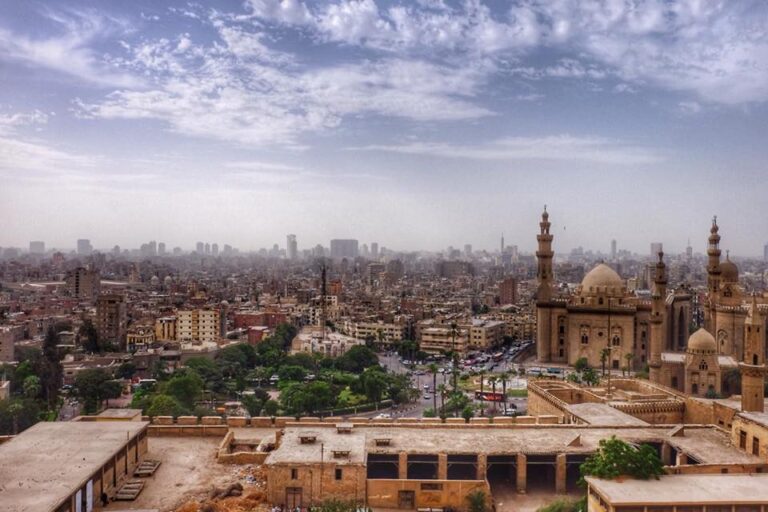
Coptic Old Cairo is the oldest area of Cairo and includes mosques, churches, synagogues and a Roman fortress, with great diversity within one area. Highlights include the Roman fortress of Babylon, the Hanging church, Abu Serga church, Ben Ezra synagogue and the Coptic museum includes masterpieces of Coptic art from the beginnings of Christianity in Egypt.
The Citadel was built to protect Cairo from the Crusaders, construction under Saladin began
in 1176 AD. The impressive fortress includes museums, palaces, mosques and terraces with expansive views over Cairo. Rulers of Egypt lived here for about 700 years. The highlights are the Mohamed Ali mosque, also known as the Alabaster mosque, built 1830-1848 AD and including the tomb of Mohamed Ali, and Al-Nasir Mohammed Mosque.
We enjoy lunch at Al Azhar park in the centre of Cairo on top of a hill overlooking the city.
Walking tour in Al-Mu’izz Street, the area with the best preserved medieval Islamic architecture: mosques including Azhar mosque and university, madrasa (schools), houses with exquisite details, mausoleums, sabils (public fountains for drinking water), wikalas (caravanserai), Sufi monasteries, synagogues, and markets. Our visit to Khan el Khalili market is a unique experience of walking through a bazaar which began its life in 1382 and continues its vibrant life in modern Egypt. It is an opportunity to see examples of many Egyptian crafts and Fishawy, a historic cafe.
Disclaimer: In case of complications in the sailing, slight changes may happen in the order of doing activities within the tour or dropping any of the attractions above. We will endeavour to
minimise any changes.
| Quotation in USD - Per Person in a group of --- | 1 | 2 | 3 | 4 | 5 | 6 | 7 | 8 | 9 | 10 | 11 | 12 | 13 | 14 | 15 |
upgrade to suite is available when requested for an extra charge (subject to availability). For Christmas & Easter Periods: Supplement 120 USD Per Person in Double Room
|
2796 | 2150 | 1963 | 1845 | 1743 | 1714 | 1658 | 1617 | 1691 | 1655 | 1625 | 1600 | 1578 | 1560 | 1545 |
|
Accommodation per person in Double
Cairo : 4 Nights in Holiday Inn Maadi in Double Standard room Luxor : 1 night in Embrace in Double Superior room Aswan : 1 night in Artika Wadi Kiki in Double Deluxe Chalet Alexandria : 1 Night in Paradise Metropole in Double Deluxe room With Sea view or Similar according to availability, For Christmas & Easter Periods: Supplement 92 USD Per Person in Double Room Rooms upgrades are available for an extra charge. Other hotels are available - ask for.
|
678 | 678 | 678 | 678 | 678 | 678 | 678 | 678 | 678 | 678 | 678 | 678 | 678 | 678 | 678 |
| Grand Total per person in USD | 3474 | 2827 | 2641 | 2522 | 2420 | 2391 | 2336 | 2294 | 2369 | 2332 | 2302 | 2277 | 2256 | 2238 | 2222 |
| Single Supplement . USD | 1170 | 1170 | 1170 | 1170 | 1170 | 1170 | 1170 | 1170 | 1170 | 1170 | 1170 | 1170 | 1170 | 1170 | 1170 |
| Triple Deduction . USD | 149 | 149 | 149 | 149 | 149 | 149 | 149 | 149 | 149 | 149 | 149 | 149 | 149 | 149 | 149 |
|
Not Including:
|
|||||||||||||||
|
Notes:
|
© Dahabiya Nile Sailing Egypt 2024